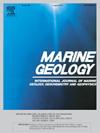深海沉积物原位岩土力学性质及多金属结核开采的环境影响
IF 2.2
3区 地球科学
Q2 GEOSCIENCES, MULTIDISCIPLINARY
引用次数: 0
摘要
全球海床上的多金属结核是重要金属的巨大资源,同时正在评价采矿活动造成的环境影响,例如沉积物扰动和羽流扩散。承载结核的地表沉积物的岩土力学性质将严重影响采矿作业。然而,岩土力学性质和泥沙输运及沉积动力学的空间变化却鲜为人知。在中国五矿合同区克拉里昂-克利珀顿断裂带西部的11个测点进行了原位穿透强度试验。通过建立沉积物穿透强度(表明基质硬度)、等深位置指数(BPI,一种地形起伏度的度量)和沉积物粒度之间的定量关系,我们观察到,与地形低洼(洼地)相比,地形高处(高地)表现出更粗的沉积物和更硬的基质。这一观察结果与横向沉积物再分配模型非常吻合,即沉积物从高地被侵蚀并在洼地重新沉积。我们的研究结果表明,高原上较硬的基底会减少采矿车辆的沉陷和沉积物扰动,从而减轻沉积物羽流。因此,与在洼地采矿相比,在高地优先开采结核可能产生更小的环境影响和更快的生态系统恢复。本文章由计算机程序翻译,如有差异,请以英文原文为准。
In-situ geotechnical properties of abyssal sediments and implications for environmental impacts of polymetallic nodule mining
Polymetallic nodules on the global seabed are an enormous resource for critical metals, while environmental impacts caused by mining activities such as sediment disturbance and plume diffusion are under evaluation. Geotechnical properties of surface sediments hosting nodules will critically impact mining operations. However, the spatial variation in geotechnical properties and sediment transport and deposition dynamics are poorly known. We carried out in-situ penetration strength tests at 11 stations in the China Minmetals Contract Area, western Clarion-Clipperton Fracture zone. By establishing a quantitative relationship between sediment penetration strength (indicative of substrate hardness) and the bathymetric position index (BPI, a measure of topographic relief) and sediment grain size, we observed that topographic highs (highlands) exhibit coarser sediments and harder substrates compared to topographic lows (depressions). This observation aligns well with a lateral sediment redistribution model, where sediment is eroded from elevated areas and redeposited in depressions. Our findings suggest that a harder substrate on highlands would lead to reduced mining vehicle subsidence and sediment disturbance, thereby mitigating sediment plumes. Consequently, preferential nodule mining on highlands is likely to yield lower environmental impact and faster ecosystem recovery compared to mining in depressions.
求助全文
通过发布文献求助,成功后即可免费获取论文全文。
去求助
来源期刊

Marine Geology
地学-地球科学综合
CiteScore
6.10
自引率
6.90%
发文量
175
审稿时长
21.9 weeks
期刊介绍:
Marine Geology is the premier international journal on marine geological processes in the broadest sense. We seek papers that are comprehensive, interdisciplinary and synthetic that will be lasting contributions to the field. Although most papers are based on regional studies, they must demonstrate new findings of international significance. We accept papers on subjects as diverse as seafloor hydrothermal systems, beach dynamics, early diagenesis, microbiological studies in sediments, palaeoclimate studies and geophysical studies of the seabed. We encourage papers that address emerging new fields, for example the influence of anthropogenic processes on coastal/marine geology and coastal/marine geoarchaeology. We insist that the papers are concerned with the marine realm and that they deal with geology: with rocks, sediments, and physical and chemical processes affecting them. Papers should address scientific hypotheses: highly descriptive data compilations or papers that deal only with marine management and risk assessment should be submitted to other journals. Papers on laboratory or modelling studies must demonstrate direct relevance to marine processes or deposits. The primary criteria for acceptance of papers is that the science is of high quality, novel, significant, and of broad international interest.
 求助内容:
求助内容: 应助结果提醒方式:
应助结果提醒方式:


